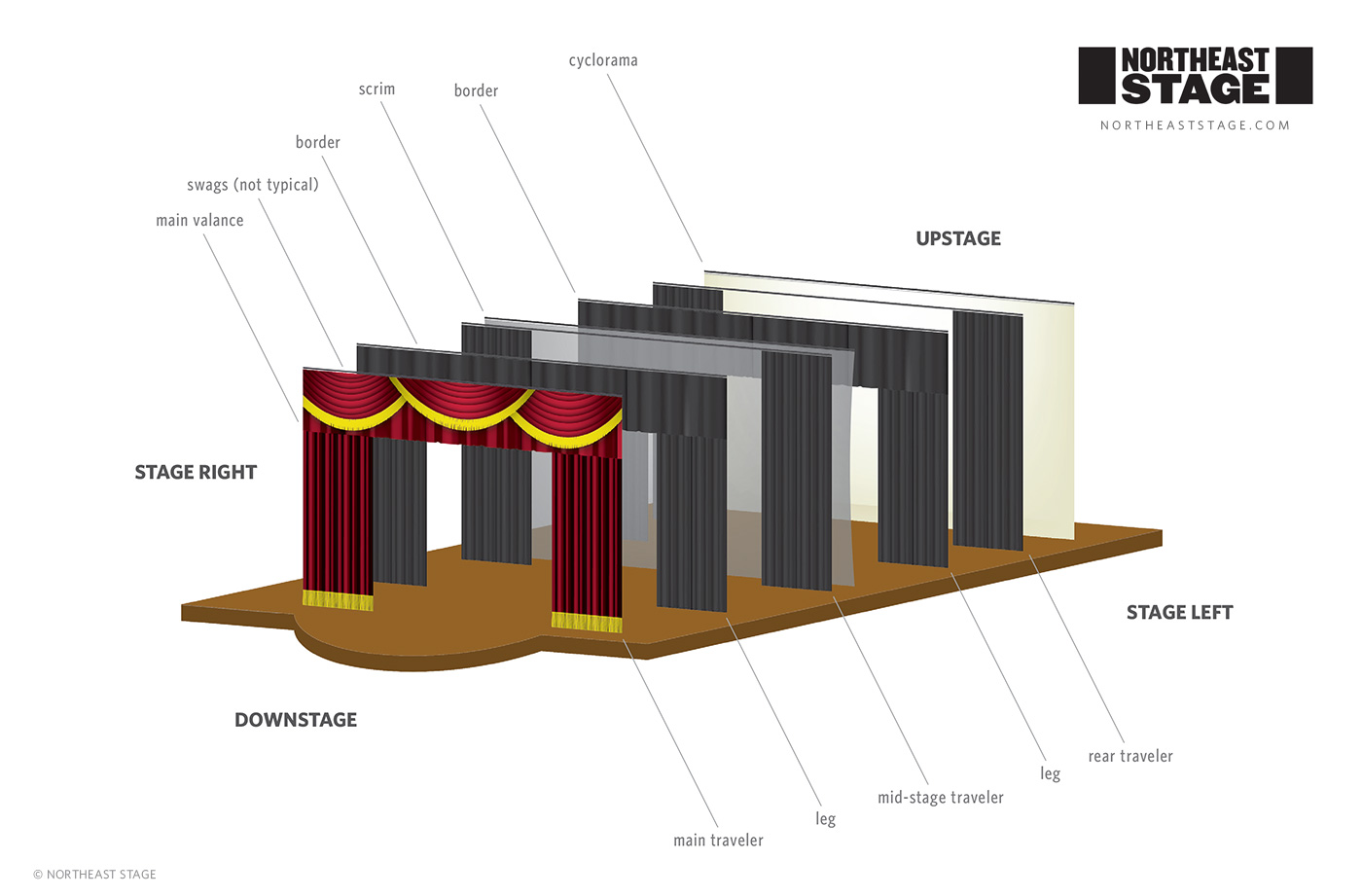
Stage Curtain Layout Basics

A typical stage layout is comprised of Proscenium Curtains, Masking Curtains, and Backdrops.
Proscenium Curtains
Proscenium Curtains include the Main Curtain, the Main Valance, and sometimes Tormentor Curtains (Torms) or Teasers. Proscenium Curtains are typically the curtains closest to the audience (most downstage). They often match the décor of the theater in color and style, are sewn with fullness, and function as a sight and sound barrier between the audience and the actors.
The Main Curtain, also know as "House Curtain, Front Curtain, Main Act Curtain, Grand Curtain," or "Proscenium Curtain" is a full length curtain used to define the stage location and open and close the view of the stage to the audience. The most common type of Main Curtain is a Bi-Parting Traveler Curtain, which parts in the middle, is hung from track, and moves to the sides (or "off-stage"). The Main Curtain can also be much more elaborate such as with an Austrian, Venetian, Tableau (Tab) or Venetian Contour. It may also have decorative detail such as trim, lame, and bullion fringe.
Often, the Main Curtain is accompanied by the Main Valance, a shorter curtain used to mask the Main Curtain hardware as well as provide a complementary decorative element. The Main Valance can be a simple flat or pleated curtain, or act as a more elaborate design element such as an Austrian Valance, Swags, or a Lambrequin. It may have decorative detail such as trim, lame, bullion fringe, or embroidered letters or emblems.
Tormentor or "Torm" curtains are full length Proscenium Curtains that are are sometimes placed upstage (behind the Proscenium Opening) in order to reduce the width of the Proscenium Opening for certain performances.
Teasers, are shorter Proscenium Curtains placed upstage (behind the proscenium) in order to reduce the height of the Proscenium Opening for certain performances.
Masking Curtains
Masking Curtains are typically black in color and are used to define the top and side limits of the stage as well as to mask or hide actors, hardware, lighting, and unused scenery. Borders, Traveler Curtains, and Legs are all examples of masking curtains.
Borders are typically shorter curtains that span the width of the stage. They are used to mask hardware, track, and lighting from the audience. They can be sewn flat or with fullness.
Bi-Parting Traveler Curtains part in the middle, are hung from track, and move to the sides (or off-stage) of the stage. One Way Draw Traveler curtains are made in one part and hung from track. They move from one side of the stage and stack on the opposite off-stage edge. Travelers can be used to divide scenes and hide unused scenery and actors. They can be sewn flat or with fullness.
Legs are typically floor length curtains that are used to mask off the off-stage (left and right) sides of the stage (or wings), concealing actors, and unused sets. They are typically installed parallel to the Proscenium Opening, but can be angled or installed on pivots for maximum side masking. They can be sewn flat or with fullness.
Backdrops
Backdrops are typically floor length curtains at the upstage (back) portion of the stage. Examples of backdrops include Scrims, Cycloramas (Cycs), Leno, and custom printed drops.
Scrim Backdrops are made of a special material that can look opaque or transparent depending on how it is lit. Certain types can also be painted.
Cycloramas are usually constructed of Muslin fabric which can be used for lighting or projection. Certain types can also be painted.
Leno Drops are constructed of a special material, which diffuses and softens light, and are often called a "filled scrim."
Custom Printed drops can be digitally printed or manufactured using Dye Sublimation to create a backdrop from your custom artwork.
Subcategories



